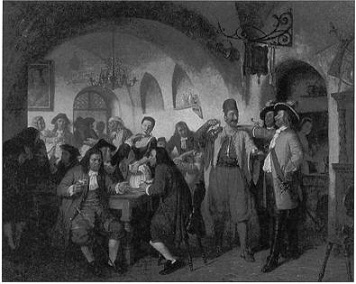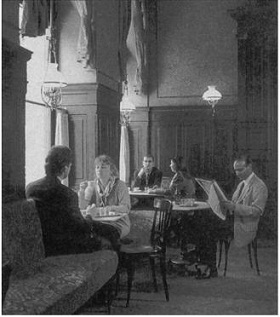The World of Caffeine (15 page)
Read The World of Caffeine Online
Authors: Bonnie K. Bealer Bennett Alan Weinberg

The legend adds that, after the crisis had passed, the city fathers of Vienna asked Kolschitzky to name his reward. He disingenuously asked only for the bags of camel fodder that had been abandoned by the retreating Turks, along with their guns, armor, tents, and other appurtenances of war, and was granted his wish. The “camel fodder,” as he, and he alone in Vienna, well knew, was actually five hundred pounds of green coffee beans, the virtues of which and the methods of roasting, grinding, and boiling he had learned in his travels to the East. Using this supply, he opened the first coffeehouse in Vienna, known as the “Blue Bottle,” but found a limited market. Then he struck upon the idea of using sugar and milk to attenuate the bitter, thick brew. After this innovation, coffee attained the great popularity in Vienna that it has maintained to this day.
The truth about the first coffeehouse in Vienna was more mundane. Vienna’s archives reveal that Kolschitzky was forced to petition the town council for years, reminding them of his valuable wartime services, before being granted a permit to do business in what was then, as now, a tightly controlled and regulation-ridden city. He had run afoul of the trade restrictions of the day, often grounded in the protection of the rights of various guilds to practice their crafts or trades to the exclusion of all outsiders.
Despite the color and charm of the story of Kolschitzky, it is now thought that at least two coffeehouses had been open for business in Vienna, possibly before the siege of 1683 and almost certainly before Kolschitzky’s petition had been granted. Two Armenians, Johannes Diodato and Isaak de Luca, are believed to have been the first to sell coffee from permanent premises.
20
Diodato, whose father was a Turkish convert to Roman Catholicism who had settled in Vienna’s thriving Armenian community, obtained the rights to sell Turkish goods in Vienna and enjoyed fabulous commercial success with many commodities. On January 17, 1685, Diodato obtained the first permit in Vienna to open a coffeehouse, although he probably had operated it earlier without benefit of the legal protection from competition that the license afforded. He finally secured a royal monopoly from Leopold I on the sale of coffee in the city for twenty years. Unfortunately for Diodato, his extensive commercial intercourse with the Turks, which was the basis for his success, also brought him under suspicion, and he was forced to flee to Venice in 1693, turning over the operation of his coffeehouse to his wife.

Kolschitzky’s Café,
oil painting by Franz Schams. This painting hangs in the main boardroom of Julius Meinl, A.G., an international company that began almost a hundred and fifty years ago as a Viennese coffee-roasting firm. The company’s founder erected a factory on the spot where Kolschitzky found the abandoned Turkish bean bags. (Photograph courtesy of Julius Meinl, A.G., Vienna, Austria)
In 1697 de Luca secured the right to do business in Vienna and married the daughter of a wealthy citizen. Fortunately for him the city fathers were then asserting themselves against the abundance of restrictive royal concessions. Later in the same year, together with two other Armenians, Andreas Pain and Philip Rudolf Kemberg, de Luca acquired a license from the city which gave him, in derogation of Diodato’s royal license, the exclusive right to trade in coffee, chocolate, tea, and sherbet. Diodato’s wife was in no position to argue on behalf of her absent husband, because the royal grant to him had been inalienable.
21
De Luca immediately opened a coffeehouse to take advantage of his new privileges. By the time Diodato returned to Vienna in 1701, he must have been astonished to see the growth of the coffee business. Perhaps promoted effectively by the example of the new Turkish embassy staff, who consumed several tons of coffee a year, coffee had come into almost universal use, and the number of coffeehouses exploded accordingly. In 1714, eleven coffee makers joined to found a trade association, and the coffee trade in Vienna had come of age. As coffee grew in popularity, a bitter contention arose between the coffee-boilers guild and the distillers guild. In 1750 Maria Theresa finally settled the quarrel by forcing the coffee-boilers to sell alcohol as well as coffee and the tavern keepers to sell coffee as well as alcohol, a measure which unified the two guilds.
On the advice of Greiner, one of her ministers, she later imposed a tax on alcohol so heavy that it helped coffee to increase in popularity.
Between the end of the nineteenth century and the early twentieth century, from before the First World War to the start of the Second, Vienna became notable for its cafés and café society. People of every sort, from professional men and civil service workers and artists and students, to unemployed laborers and penniless émigrés, would pass hours in the cafés. One of the funniest stories to emerge from this Viennese coffeehouse milieu is about Leon Trotsky:

A modern café in Vienna. (Photograph courtesy of Julius Meinl, A.G., Vienna, Austria)
There was a little-known Russian émigré, Trotsky by name, who during World War I was in the habit of playing chess in Vienna’s Café Central every evening. A typical Russian refugee, who talked too much but seemed utterly harmless, indeed, a pathetic figure in the eyes of the Viennese. One day in 1917 an official of the Austrian Foreign Ministry rushed into the minister’s room, panting and excited, and told his chief, “Your excellency… Your excellency… Revolution has broken out in Russia!” The minister, less excitable and less credulous than his official, rejected such a wild claim and retorted calmly, “Go away…. Russia is not a land where revolutions break out. Besides, who on earth would make a revolution in Russia? Perhaps Herr Trotsky from the Café Central?”
22
A Turkish adage admonishes that coffee should be sweet; but Turkish coffee, as originally prepared, was bitter indeed. Despite this fact, when Vesling visited Cairo in the early seventeenth century, he found two thousand to three thousand coffeehouses, and noted that “some did begin to put sugar in their coffee to correct the bitterness of it, and others made sugarplums of the berries.” Boiled or brewed coffee, as prepared by the Egyptians, Arabs, and Turks, was unpleasant to most European tastes. By 1670, while Viennese traditionalists sat cross-legged and sipped poisonously potent coffee in tiny cups, Eastern style, the first “coffee machines” were being invented in England and France and the Westernization of coffee consumption was under way. These were the first of an abundant variety of devices that culminated in the microprocessor-driven machines of today.
At this time, books instructing the public in coffee preparation began to proliferate. Nicholas de Blegny (1652–1722), a French surgeon who practiced without benefit of a medical diploma, wrote
Le Bon Usage du Thè, du Caffe et du Chocolate
pour la preservation & pour la guerison des Maladies
(Lyons, 1687), or
The Proper Use of Tea, Coffee, and Chocolate for
the preservation of health and overcoming Diseases,
what may be the first European work on the preparation of all three beverages that did more than simply parrot travelers’ accounts. Jacob Spon and Philippe Sylvestre Dufour also provided their readers with good instructions. In 1685 the first serious coffee recipe book was published in Vienna. By the year 1700, books and pamphlets, generally authored by interested parties, such as coffee dealers or coffee-promoting doctors, became common in England and Holland as well.
The single greatest technological revolution in the preparation of coffee was invented by a diligent and creative German housewife in the twentieth century. In 1908, Frau Melitta Bentz, with no more exalted purpose than preparing good coffee to please her husband and her Kaffeeklatsch friends, invented what the world has come to know as “filter drip coffee.” Previously, one or another variations in boiling ground beans had been used exclusively. The result was usually bitter and sometimes laden with the coarse grounds, although even before Bentz’s invention, the use of a cloth bag to screen the boiling grounds had become common. At first she tried linen towels, which did not work well, but then she tried blotting paper placed in a brass pot with a perforated bottom. Pouring water into the brass container, she succeeded in making the world’s first filtered coffee.

Pre-World War II Viennese fancy grocer on Karntnerstrasse, specializing in coffee and tea, prepared for take-out or bagged for home brewing. (Photograph courtesy of Julius Meinl, A.G., Vienna, Austria)
Bentz soon replaced the blotter paper with a strong porous paper, the sort we are familiar with today, and engaged a tinsmith to produce aluminum pots, more than a thousand of which were sold at the Leipzig Trade Fair. Encouraged by this early success, Bentz’s husband created and assumed the management of a company in 1912, which he named after his wife, to produce the coffeepots and filters. Despite improvements and variations, the basic Melitta method of making coffee, which is simple, dependable, convenient, and produces a rich, clear brew, is still in use today in more than 85 percent of German households and in almost every country around the world.
23
The fashions of preparing, serving, and drinking tea also evolved. The Europeans imitated the Chinese, who made tea in unglazed red or brown, plain or decorated stoneware pots, the use of which they believed made for the best brew. These stoneware pots arrived with the first Dutch shipments of tea and were subsequently widely copied by European craftsmen.
The Portuguese and Spanish began to return from the Orient with porcelain as early as the sixteenth century, but, because of porcelain’s expense, its use outside their homelands remained limited.
24
This changed when the Dutch began to import large quantities of Chinese and Japanese porcelain, making it cheaper and spreading its use by reexporting it throughout the Continent. It was so cheap in its countries of origin that the Dutch captains loaded their holds with tons of porcelain to ballast their ships, making the previously rare commodity increasingly common. As early as 1615, published accounts make certain that Chinese porcelain was in everyday use in most Dutch homes. As ordinary as these imports had become, some still saw in them the hallmark of exotic splendor. In 1641, the Dutch physician Nikolas Dirx, “Dr. Tulpius,” wrote of the delicate, handleless porcelain cups and opulent tea services that were now being used in his country: “the Chinese prize them as highly as we do diamonds, precious stones and pearls.” Later, so much porcelain was brought into England by that country’s East India Company that it can fairly be said that never, before or since, had ordinary people, poor by our standards, drank or dined with such luxurious appurtenances.
Porcelain was coveted because of its beauty and impermeability, which made it easy to wash. During the seventeenth century, almost all the porcelain brought to Europe was the Ming blue-and-white variety. The Dutch began copying the Ming ceramics and, by the middle of the century, the famous blue-and-white Delft potteries produced credible imitations of the Eastern originals in the chinoiserie style that was later to become popular in Europe.